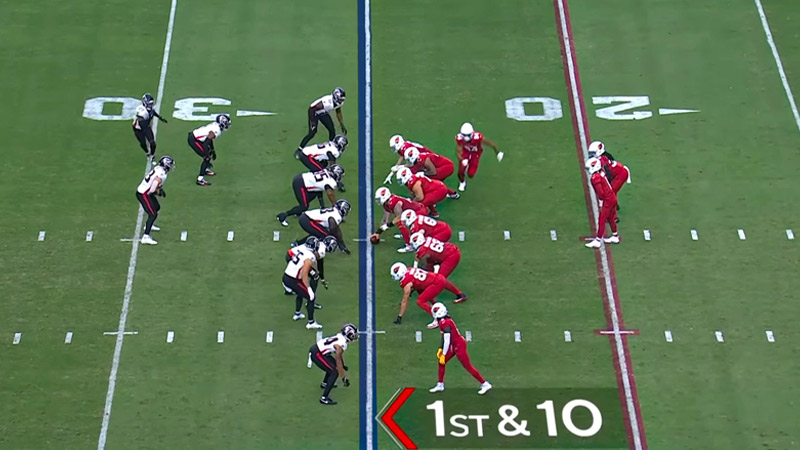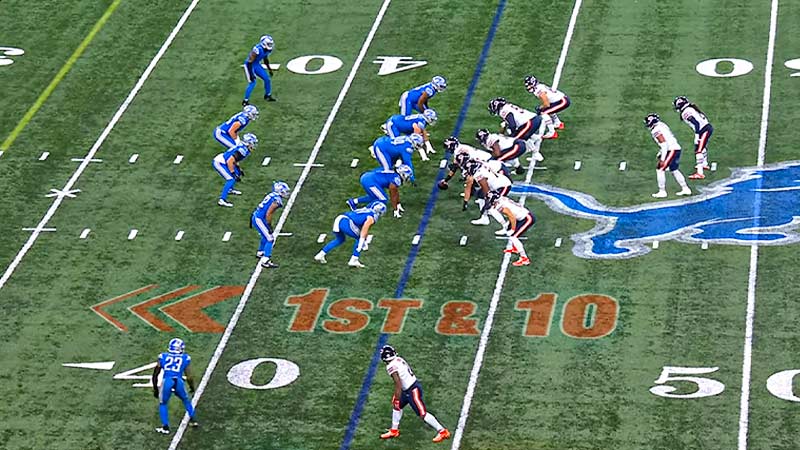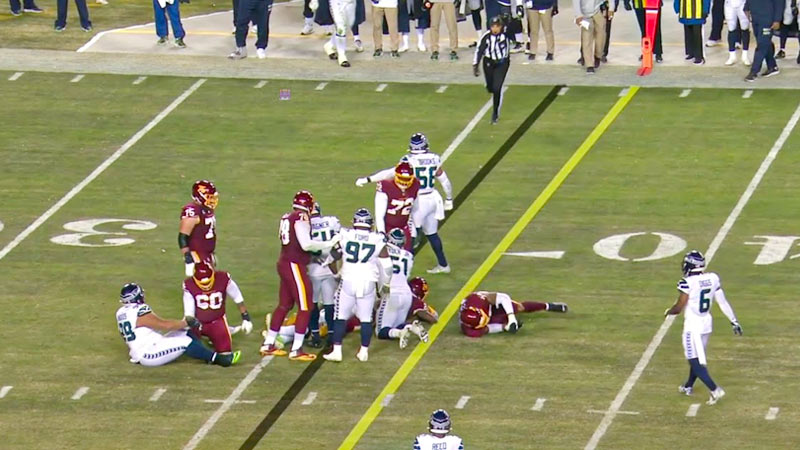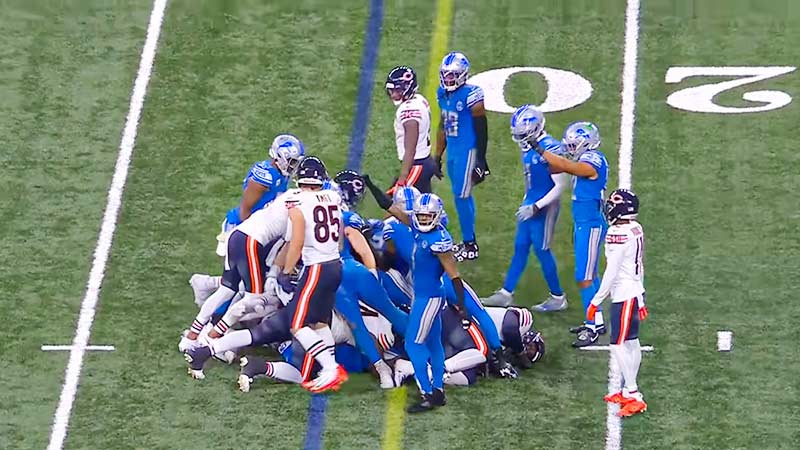American football’s heart beats at the line of scrimmage, an invisible boundary that shapes every play.
Exploring “American Football Line of Scrimmage Rules,” we delve into the core regulations governing this pivotal aspect of the game.
From pre-snap dynamics to the consequences of encroachment, understanding these rules is essential for players, coaches, and avid fans.
At this critical juncture, we unravel the nuances of offside violations, legal formations, and the intricate dance between offence and defence.
Join us on a journey through the strategic and tactical elements that unfold at the line of scrimmage, unravelling the mysteries behind the snap that kickstarts every thrilling play. So, stay focused.
What Is the American Football Line of Scrimmage?
The line of scrimmage in American football is an imaginary line that extends across the width of the field and passes through the point of the football before each play.
It represents where the ball is placed at the start of the play and serves as the boundary for offensive and defensive players.
Before the snap, offensive players must line up on one side of the line of scrimmage, while defensive players position themselves on the other.
Here are some less commonly known or discussed critical points related to the American football line of scrimmage:
Unbroken Plane Rule
The ball doesn’t physically have to touch the ground on the line of scrimmage. Instead, if any part of the ball breaks the vertical plane of the line of scrimmage, it is considered legally positioned.
Quarterback’s Free Movement
In a shotgun formation, the quarterback can move laterally parallel to the line of scrimmage before the snap without penalty, offering more flexibility in play calling.
Ineligible Receiver Downfield
Offensive linemen are restricted from advancing more than three yards downfield before throwing a pass. If they do, it can result in an ineligible receiver downfield penalty.
Defensive Offside Tolerance
While encroachment by the defense is penalized, there is a margin of error. If the defender immediately withdraws after entering the neutral zone and does not contact an opponent, it may not be penalized.
Neutral Zone Infraction vs. Offside
In a neutral zone infraction, if a defensive player causes an offensive player to move (false start) by entering the neutral zone, it’s not penalized as offside but as a neutral zone infraction.
These nuances add depth to understanding the line of scrimmage rules in American football.
The line of scrimmage dictates where the play begins, and players cannot cross it until the ball is snapped. This fundamental aspect of the game is crucial for maintaining a fair and organized contest between the offense and defense.
The Basics of the Line of Scrimmage

The line of scrimmage is a fundamental concept in American football, shaping the dynamics of each play. Understanding its basics is essential for both players and fans.
Imaginary Boundary
The line of scrimmage is an imaginary horizontal line that spans the width of the football field, passing through the point of the football before every play.
Pre-Play Setup
Before the snap, offensive players must line up on one side and defensive players on the other, respecting the line of scrimmage as the point of reference.
Ball Placement
The line of scrimmage determines where the ball is placed at the beginning of each play, influencing the offensive strategy and the defence’s positioning.
Snap Trigger
Players on both teams cannot cross the line of scrimmage until the ball is snapped, marking the commencement of the play.
Fair Play Indicator
The line of scrimmage ensures a fair and organized game, preventing players from encroaching on each other’s territory before the play starts.
Dynamic Game Element
As the focal point for the start of every play, the line of scrimmage adds a dynamic element to the game, influencing tactics, formations, and the overall flow of the match.
Football Line of Scrimmage Rules

Understanding the rules governing the line of scrimmage is crucial for American football players, coaches, and fans.
These rules shape the dynamics of the game and influence strategic decisions on both offense and defense.
Offside Violations
We are crossing or encroaching the line of scrimmage before the ball is snapped, resulting in an offside penalty. This infraction incurs a yardage penalty against the offending team.
Neutral Zone Infractions
Defensive players must avoid entering the neutral zone, the space between the offensive and defensive lines, before the snap.
A violation is penalised unless the offense reacts, causing the defense to jump offside.
Legal Shifts and Motions
The offense can shift or move players before the snap if they do not cross the line of scrimmage. This allows teams to create misdirection and confuse the defense.
Illegal Formation
The offense must have a certain number of players on the line of scrimmage to maintain a legal formation. Violations can result in penalties, impacting the down and distance.
Snap Timing
The ball must be snapped within a specific timeframe after the teams are set. Delays can result in penalties for delay of game, affecting field position.
Quarterback Position
When under centre, the quarterback must have a part of their body directly over or behind the line of scrimmage during the snap. This rule ensures a fair starting point for both offense and defense.
Football Line of Scrimmage Formations

The line of scrimmage in football is a reference point for starting plays and a canvas for strategic formations that teams employ to gain a competitive edge.
Various offensive and defensive formations are designed around this critical game element.
Single-Back Formation
In this standard offensive setup, the quarterback lines up directly behind the centre at the line of scrimmage while a single running back stands in the backfield.
This formation offers versatility in play-calling, allowing for both passing and running plays.
Shotgun Formation
Contrasting the single-back formation, the shotgun sees the quarterback positioned a few yards behind the line of scrimmage.
This gives the quarterback more time and visibility to make passing decisions, but it can limit the effectiveness of running plays.
I-Formation
In the I-formation, a running back aligns directly behind the quarterback, with a fullback in front of them.
This formation is favoured for power running plays, with the fullback often serving as a lead blocker.
4-3 Defense
On the defensive side, the 4-3 formation involves four defensive linemen positioned along the line of scrimmage, three linebackers behind them, and four defensive backs.
This balanced setup aims to provide both strong run defense and pass coverage.
3-4 Defense
In contrast, the 3-4 defence features three defensive linemen and four linebackers.
This formation creates more versatility in pass-rushing and coverage schemes, often surprising opposing offenses.
Goal Line Formation
Teams often adopt a specialised formation near the opponent’s goal line with extra defensive linemen to prevent short-yardage running plays.
On offense, a heavy formation with additional linemen may be used to power through for a touchdown.
Techniques for Dominating the Line of Scrimmage

Dominating the line of scrimmage is a critical objective in football, as it can significantly impact the outcome of a game.
Both offensive and defensive teams employ specific techniques to gain an advantage at this critical point on the field.
Offensive Line Techniques
Offensive linemen use techniques such as the “drive block” to push defenders backwards, creating openings for running backs.
Proper hand placement, leverage, and footwork are crucial for offensive linemen to establish control and create running lanes.
Defensive Line Techniques
Defensive linemen aim to disrupt the offensive line by using techniques like the “bull rush” to overpower blockers.
Employing effective hand fighting, leverage, and quick bursts of the line can help defensive players penetrate the offensive line and disrupt plays.
Stunts and Twists
Offensive and defensive lines can utilize stunts and twists, where players execute coordinated movements to confuse the opposing line.
This strategic approach can create mismatches and open up opportunities for big plays.
Low Man Wins
Whether on offense or defense, maintaining a low pad level is essential for winning battles at the line of scrimmage.
The lower player often has better leverage and is likelier to control the engagement.
Hand-Fighting Techniques
Offensive and defensive linemen engage in hand-to-hand combat at the line of scrimmage.
Mastering hand-fighting techniques, such as swimming and rip moves, allows players to shed blocks effectively and gain an advantage.
Gap Control
Defenses focus on gap control to limit the running lanes available to the offense.
By maintaining discipline and controlling specific areas along the line of scrimmage, defenders can force running backs into less favourable areas, disrupting offensive plans.
FAQs
What happens if a player crosses the line of scrimmage before the ball is snapped?
Crossing the line of scrimmage prematurely results in an offside penalty. The offending team is penalized five yards, impacting the down and distance.
Can offensive players move before the snap without penalty?
Yes, offensive players can shift and move before the snap, as long as they don’t cross the line of scrimmage. This allows teams to create strategic formations and misdirection.
Are there restrictions on defensive players before the snap?
Defensive players must avoid entering the neutral zone (the space between the offensive and defensive lines) before the snap. Violations result in penalties unless the offense reacts.
What is the consequence of an illegal formation related to the line of scrimmage?
An illegal formation occurs when the offense doesn’t have the required number of players on the line of scrimmage. Penalties for illegal formations can result in a loss of yards, affecting the down and distance.
How does the line of scrimmage impact the timing of a play?
After the teams are set, the ball must be snapped within a specified timeframe. Delays in snapping the ball can lead to penalties for delay of game, affecting field position and strategy.
Wrapping Up
In American football, the line of scrimmage isn’t just a marker on the field; it’s the epicentre of strategy and competition.
One gains insight into the chess match unfolding play-by-play by comprehending the rules governing this invisible line.
The American Football Line of Scrimmage Rules serves as the unseen orchestrator, guiding the ebb and flow of the game.
Whether you’re a seasoned enthusiast or a newcomer to the sport, appreciating the significance of this foundational element adds a layer of depth to the spectacle on the gridiron, transforming each snap into a moment of strategic brilliance. Thank you for your time.






